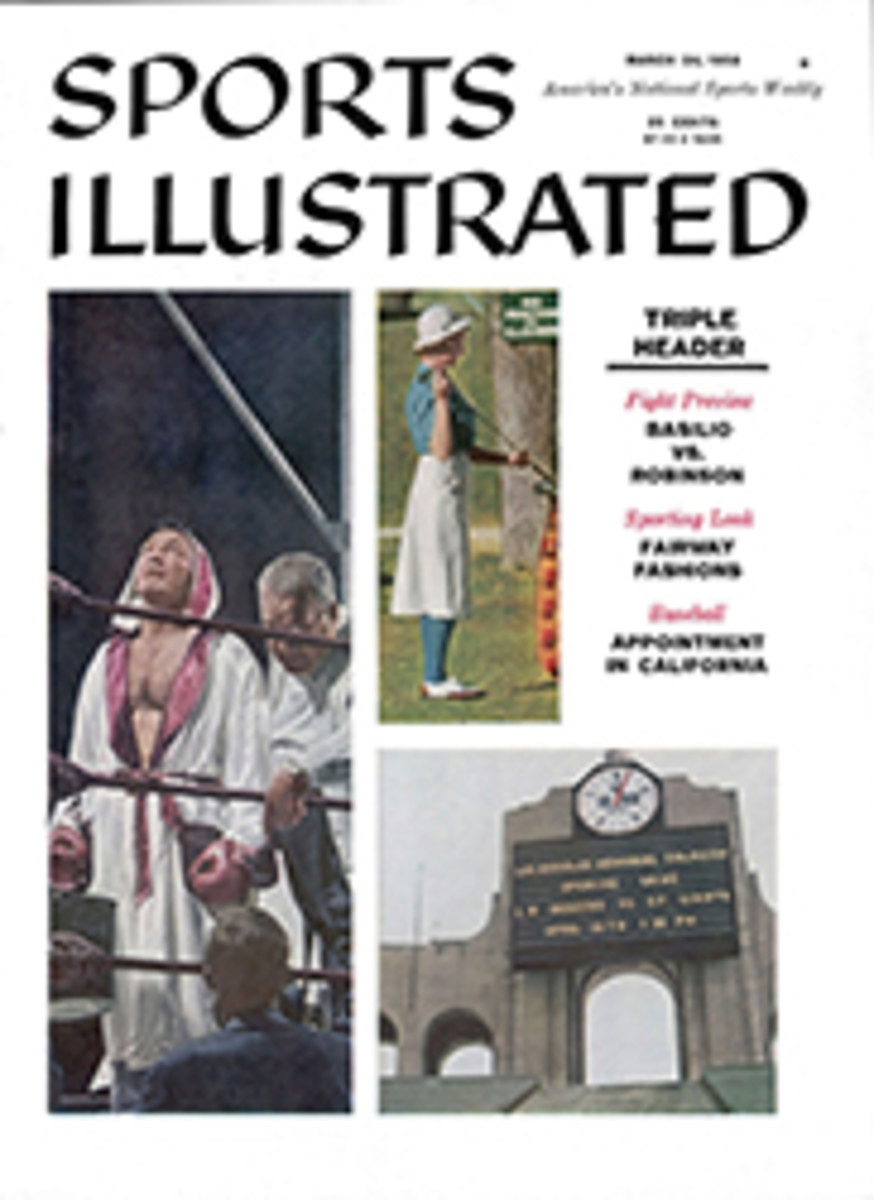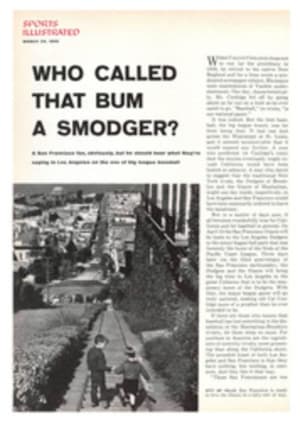
Footloose in Two Cities
The differences between Los Angeles and San Francisco, which have been discussed in words poetic by everyone from a visiting orthographer to a visiting O'Malley, are nowhere more apparent than in a comparison of the ball parks in which the emigrant teams will exercise this summer. Los Angeles Memorial Stadium, otherwise known as the Coliseum, the new playground of the Dodgers, is a historic oval in the greening acreage of Exposition Park, perhaps 40 minutes from the Sunset Strip and 20 minutes from downtown L.A. Picnickers and shorts-wearing strollers promenade in its bucolic surroundings. Tall palms shinny up the cement walls like small boys seeking a free look inside. Banana fronds and orange birds-of-paradise blooming in a font in front of the gates will be a startling sight to the Dodgers, whose greenest memory of Brooklyn includes nothing more pastoral than a ripe raspberry.
At the outset anyway, no such vaunted arena awaits the Giants when they arrive in San Francisco. Little Seals Stadium is tucked away in a frumpy neighborhood, $2 by cab from downtown. From the stands the view looks over the backfield to the rise of Potrero Hill, where the bohemians are moving, so it is said, because they can no longer afford Telegraph Hill. Beyond, the view expands to the bay and to Oakland climbing the hills in the distance. Stempel's doughnut works next door sends intoxicating odors into the seats with every updraft, and immediately behind the grandstand Hamm's brewery puffs smoke like a contemplative spectator.
Much has been made of the cuisine available by the bay, and it is certainly true that in San Francisco many a battle of the waistline has been lost on the playing fields of eatin'. But in addition to the Giants and groceries Baytown can keep a visiting ball fan busy at a variety of endeavors.
For instance, on free afternoons before night games, an Ausl√§nder with time on his hands can, for 15¢, board the cable car at its Market Street turntable, down where San Francisco lives on a rational plateau. Sitting on an outside bench with a freshet blowing in from the sea, the passenger can without effort climb up the famed hills, past Bernstein's Fish Grotto and Sears', famous for its 18 pancakes. The end of the line is anchored by the Buena Vista, a bohemian saloon which offers 40 kinds of beer, including Swiss, Norwegian, and oyster stout from the Isle of Man. A plaque marks the spot where Columnist Stanton Delaplane introduced Irish coffee to the United States.
It's two blocks down the street to Fisherman's Wharf, where seagulls and tourists stroll along Jefferson Street and the giant cracked crabs boil in pots and are in season from November 15 until the first of August. You can view Alcatraz through a telescope for a quarter, or take a bay cruise, or pick at a walkaway seafood cocktail, or sign up for a fishing boat that ties up at Tarantino's and puts out for salmon. And the seafood houses that hang over the wharf serve sour-dough French bread and abalone steak, bay shrimp no bigger than a hangnail, and hangtown fry, which is fried oysters in a three-egg omelet, pancake style with a strip of bacon on top, a holdover from the Forty-Niner days.
Lunch is very masculine at Jack's, which has veteran black-suited waiters, potted palms and a small stand-up bar. Gents roll for drinks, and there are regulars who have been coming five days a week for over 30 years. San Francisco calls it a no-nonsense restaurant. Ladies and gents lunch together in the Garden Court of the Palace Hotel, now the Sheraton-Palace, under the great glass umbrella of a Victorian skylight. Sitting in the shade of delicate Japanese elms that bloom in pots, San Franciscans dawdle away the noon hour picking at oysters Romanoff (with caviar), oeufs à la tripe and Chef Lucien's original Palace Court salad, which comes in four delicious flavors, crab, chicken, shrimp and tuna.
When night falls, there is Ernie's with its red damask walls, its bar that was shipped around the Horn, and its impeccable cuisine. Two can dine for $20 at Amelio's, which serves asparagus the year round, specializes in disjointed chicken browned in butter with artichokes and zucchini and prepares game and fish for any sportsman who brings it around to be cooked. Two dollars per person, you bring the duck. In the same bracket is the Blue Fox across the street from the jail and the morgue, once a speakeasy called The Philosophers. It offers porterhouse for two at $12, cracked crab in season, and a delicate cold veal with sour cream sauce.
Kan's in Chinatown will, on prior notice, put up Peking duck and thousand-layer buns and winter melon soup served in the melon. Dried duck's feet and dried fish stomachs adorn the Chinatown windows, and for anybody on hand Sunday morning the Hang Ah Tea House puts up a dandy brunch à la Hong Kong.
At India House, an upholstered black hole redolent of Calcutta, you can munch on unleavened popadams and ancient dried fish called Bombay duck while sipping Pimm's Cups, available in all the numbers from one to four. There are 10 curries to choose from, all of them dispensed by Pakistani or Indian waiters wearing jinnah caps or turbans. By day they attend school at the University of California.
The Old Spaghetti Factory Cafée and Excelsior Coffee House, housed in an old spaghetti factory now painted pink, offers spaghetti dinners, a running little revue and steam beer, which is not carbonated but naturally fermented, like champagne, only cheaper. Candles flicker on poles, a piano flickers in a corner and customers inhale Spanish coffee at Barnaby Conrad's Matador. The beards gather to think and drink at the Co-Existence Bagel Shop, where bagels anchor the light cords. It's in North Beach alongside the Panama Canal Tagliarini, Noodle and Ravioli Factories.
Everybody seems to end up at David's, a delicatessen run by an all-night owl named David who still wears the tattoo of Sachsenhausen on his arm. The delight is a pastry called, by everybody except the proprietor, pig's ears. "Please," says David. "We don't serve pig's ears here. Palm leaves, angel's wings, but not pig's ears."
In spite of the imposing roster of restaurants which San Francisco presents, the people of Los Angeles insist they eat as well, in as many interesting towers of the haute cuisine. For pure elegance they point to Perino's, an oval room in which the practitioners of the haut monde and the haul expense account lounge on divans while being served an eminent menu, conservative choices from which will run up the bill to about $10 per diner. The Escoffier Room at the Beverly Hilton, which would tell the diner no prices when the room first opened, has modified this noble policy and not only agrees now to tell the guest what he is in for but has dropped the prices somewhat. It helps digestion. The menu, embossed with a gold wax seal and strung with a purple ribbon, offers pure French cuisine, with entrees in the $6-to-$7.50 class. A half cup of coffee costs 50¢. Downstairs the first of Trader Vic's branches, others of which will be set up in Hilton hotels in Havana and New York, cooks Polynesian, Chinese and Korean concoctions over orangewood in a pair of black tubs sealed inside a huge glass box.
On Sunset Boulevard, known also as The Strip, you might squeak out of La Rue for $10 per person, but the choice dishes (le poulet de grain en casserole and la poularde de choix Suvaroff) are in the $12-to-$16 bracket before you've even ordered chopped liver ($2). Scandia has opened a huge new Danish barn on The Strip where one can immerse oneself in a deep pile of leather and squint in the dark, near-indecent lighting at murals of Nyhavn, Tivoli and other trademarks of the Danish homeland. Nor is one's vision likely to be improved by the akvavit.
Since stargazing is hardly likely to be dislodged by baseball as one of Hollywood's favorite sports, it ought to be mentioned that Chasen's, a noisy paneled establishment, and Romanoff's, a tony nook in Beverly Hills, around the corner from the Beverly Wilshire, are the best-known hangars where astral bodies park. Strange to say, L.A. also has a number of intimate bo√Ætes that are neither chain operations nor display cases for stars. One is Villa Nova, a place so dark, so full of cubbyholes that it is not merely a celebrity-starer's nightmare, it is also, for the waiters, a sort of hide-and-seek with dishes. But the menu is extraordinary north Italian and sometimes carries such items as Belgian hare sauté with green olives, Italian herbs and dry white wine. Frascati's in Beverly Hills, run by Belgians, is the closest thing to a Gallic bistro this side of Le Havre, yet it is just up the road from Romanoff's and across the street from the ancient Beverly Wilshire.
Like many a fading Hollywood star of the same era (it was built in 1921), the Beverly Wilshire is now being overhauled. Pink and blue umbrellas and pink and blue cabanas surround its pool now, and lanai suites are being built on what was once just a gritty courtyard, but the hotel still has memories that go back to Jimmy Walker, who set up headquarters in the place when he arrived to try to spring Tom Mooney, and to Mussolini, who frantically telephoned his son there, long distance from Rome. Hecht, Hill and Lancaster are just across the street, and that makes it handy for their visiting properties, and Abe Lastfogel's permanent presence insures visits from the stable of William Morris talent. Only the other day Elvis caused a riot in the garage when a gang of local girls staged a sitdown strike in front of his car.
Despite such lapses of order as Elvis' presence might induce, Beverly Hills, after dark, is run like a tight police state. An Easterner staying at the Beverly Hills Hotel last year who decided to take a stroll after dinner one evening and didn't know the ground rules reported being picked up by a squad car and returned forthwith to his hotel. No prowling after dark, the cops told him. But don't get me wrong. I love Hollywood. So do San Franciscans. They like it right where it is. Says Herb Caen, the San Francisco Chronicle's bard of the bay, "Isn't it nice that the kind of people who prefer L.A. to San Francisco live there?"
Up on Coogan's Bluff, that's what they used to say about Flatbush.
MAP
SAN FRANCISCO
MAP
LOS ANGELES

